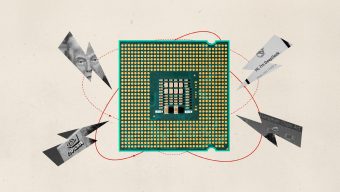Practically any conversation about business opportunity in Nigeria reverts to the same theme: digital technology is the future but the infrastructure to support it is poor.
We cannot yet talk about the digital revolution as if we have already all become avatars in a world devoid of physical objects. Bricks and mortar are still the foundations of the modern economy, even if we foresee a digital future. Even as we migrate from the physical to the digital world, we need electricity to power our homes and equipment, roads to transport goods, and schools to train youths to be able to navigate and exploit this digital future. The physical and digital must work in dynamic synergy, not in mutual isolation. The potentials are huge but can only be fully realized if we bridge the digital divide.
Nigeria’s lack of access to affordable energy, straightforward logistics, and a deep skill pool not only limits how digital technology can be deployed but also makes the country less competitive in deploying it. The digital divide, the phenomenon of the wealthy disproportionately accessing the benefits of digital technology, is well documented and understood to be growing: According to an assessment by UNCTAD in 2021, citizens of developing countries are at risk of becoming providers of raw data to global digital platforms, while having to pay for the intelligence obtained from data they have generated.
Conversations about closing the digital divide often focus on steps that can be taken to protect data, develop digital skills, and improve broadband access. However, what Nigeria should also focus on is this relationship between the digital and the physical world. The country needs investment in physical infrastructure for its citizens to fully access the benefits of digital technology. In other words, digital inclusion must be a key priority of Nigerian governments at all levels. The ideal of digital inclusion, underpinned by the three key principles of access, adoption, and application, encompasses activities through which disadvantaged groups have access and use ICTs to enable them to fully participate in society and enjoy benefits and opportunities like other citizens. There is therefore a need for significant investment in infrastructure. According to the World Bank, for example, Nigeria needs to invest $3 trillion by 2050 in order to provide all the infrastructure the economy needs to maximize its potential. but how do you about this in a vast and diverse country like Nigeria?
Modular approaches can complement large-scale infrastructure investment plans.
Unfortunately, it is unlikely these solutions are going to come from large-scale infrastructure projects in the short or even medium term. State budgets in Nigeria and elsewhere are over-extended and infrastructure investment in Nigeria comes with risks that very few investors have the appetite to take on.
Yes, investment at a massive scale is needed; however, because there are such high barriers to implementation, it is urgent to explore alternative models to building physical infrastructure that will make Nigeria more globally competitive.
A modular approach, where infrastructure-related challenges are identified and ideas are generated, explored and tested at a community or organizational level are one way to do this. By focusing problem definition from the bottom up, rather than top down, it can be easier to anticipate and respond to project bottlenecks that might delay or change scope. This type of approach can also be effective at building local capacity and designing solutions that are more consistent with local business practices.
For example, GIVO, a Nigeria-based recycling company, and its Portugal-based partner Precious Plastics, have developed a prototype of a manufacturing unit that produces bricks using low-value plastic and solar power and is affordable enough that it can be used by road-side brick manufacturers, who represent a high percentage of brick producers in Nigeria. Furthermore, because the system is designed to be modular, independent manufacturers are free to work independently and also have the choice to coordinate to meet higher demand.
When more attention is paid to local hardware innovation, it can lower the costs of goods to consumers, improve productivity, and ultimately Nigeria’s competitiveness. A drawback of the modular approach to support local innovation is that, particularly at the early stages, the potential impact is infinitesimal relative to Nigeria’s structural needs. In the GIVO example, one manufacturing unit is estimated to produce only 300 bricks per day. Quadloop is likewise not yet at a stage that it is producing or marketing solar lanterns in the volumes that are needed to make a dent in the nation’s electricity deficit.
Nevertheless, this limitation should not discourage investment in modular approaches to mobilize local hardware innovation. Modular approaches are flexible: they are designed to adapt to different needs and circumstances. This makes it less risky to experiment and easier to ramp up production when business models are proven. Modular approaches to support local hardware innovation can also be combined with larger scale investments in infrastructure and digital technology.
Through the development of manufacturing hubs, for example, Nigeria’s emerging entrepreneurs could access to equipment that would otherwise be unaffordable. This is especially compelling when considering how technologies such as 3D printing enable much more dynamic manufacturing processes. The creation of digital platforms that incorporate technologies such as blockchain can also provide smaller businesses the foundations to trade, manage inventories and accounts and to coordinate with clients and suppliers in ways that may otherwise be unobtainable. Having established linkages to financing, aggregation and logistics capacity, digital applications such as Pakam, a waste management platform that offers a window into how digital tools interact with and support investment in physical infrastructure.
We should be excited about the potential of digital technology to drive Nigeria’s economic development. For Nigerians to derive the most benefit from the digital world, it is paramount that there is more investment in physical infrastructure. The urgency of Nigeria’s infrastructure needs cannot be overstated, as such it is necessary to pave new pathways to mobilize investment. Modular approaches driven by indigenous innovation is one promising avenue because they are more responsive to local business needs. Advances in digital technology make it more affordable and feasible to support the development of local hardware innovation. Furthermore, with lessons to draw from in the Nigerian start-up community, we have the tools to plot a creative new course toward competitiveness.
© IE Insights.











